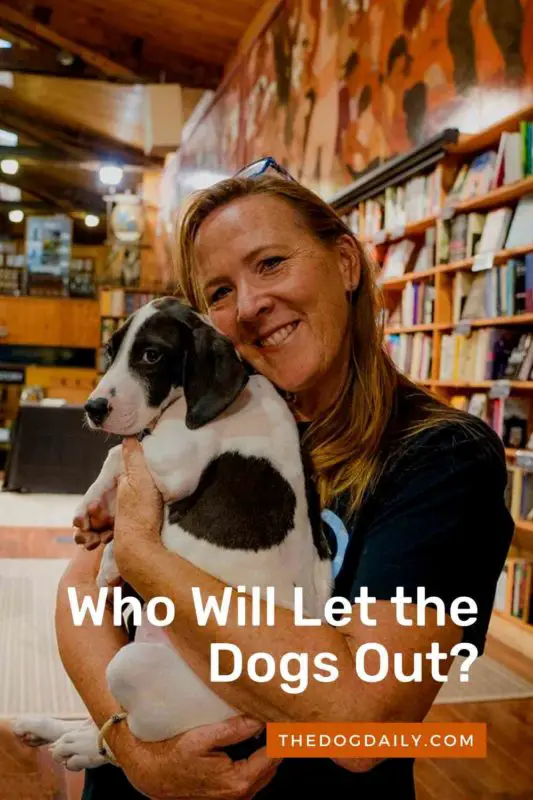Will we be No Kill by 2025?
Recently I came across an article that claimed we, as a nation, are making great strides towards addressing the problem of homeless animals dying in shelters. One of the organizations that has done the most to make that happen is Best Friends. They have truly changed the game for many, many shelters and the animals they save. They track data on thousands of shelters and rescues in the US, and their blog lists the five states where the most animals are dying: Texas, California, North Carolina, Florida, and Georgia.
The problem with the Best Friends’ system is that they are collecting information from shelters. My experience having visited nearly fifty shelters, rescues, and pounds, is that in the places where the animals are dying, there is no one reporting those deaths.
Many of the shelters I visited were unlikely to have time (or even a computer or internet connection) to generate any kind of report.
I’m certain that North Carolina makes the list not because they are necessarily killing the most animals, but because shelters are required by state law to report their numbers. They are leaps and bounds ahead of so many other states because they have a shelter in nearly every county.
In the municipal pounds of Tennessee, dogs are basically warehoused for their stray hold period and summarily executed unless a rescue pushes themselves into the situation and finds a way to save the dogs. In a few cases, there is a motivated and caring Animal Control Officer or a local resident who do what they can to reunite owners and/or find rescue for their animals. No one is counting the hundreds, if not thousands of dogs that die in these tiny forgotten dog pounds.
Halfway Home Rescue – Tennessee
I spent a day with a private, non-profit animal rescue that pulls from the local pounds in western Tennessee in addition to taking in even more animals before they land there. Halfway Home Rescue was started by a woman who was raised on rescue, helping her grandmother operate a rescue (still in existence today). The need has not changed and now Amber, and her husband Brandon (and their four kids), have begun their own rescue, officially receiving their 501c3 in March.
In the five months since they began they have saved 378 dogs and 18 cats. Their garage, backyard, and various outbuildings have all been converted into kennel space. HHR has multiple local families fostering for them also. Every dog is eventually moved out of Tennessee through rescue. They only do a handful of local adoptions and only to people they know and trust. They have seen the worst of what happens to animals in these long-lost counties that have no animal control officer or shelter, and little access to affordable veterinary care.
The day my photographer and I spent with them, we struggled to keep up. It began with us waiting for Amber in her driveway, our designated meeting spot. She had been called away to pick up a Catahoula dog and her puppies who had been abandoned. Once she arrived and got them settled, we set off to visit a few of the local pounds, but had to make a quick stop at the Tractor Supply parking lot to meet a woman who needed Amber to take her litter of six, huge, shepherd mix puppies because she could no longer afford to care for them.
Amber accepted the puppies, but then convinced the woman to spay the mama dog. As we pulled away from the woman who stood beside her Jeep in tears, I asked if she would really spay the dog. Amber said, “I’m gonna make sure it happens.” Later she would make the appointment, pick up the dog and deliver it to the vet and pay for it.
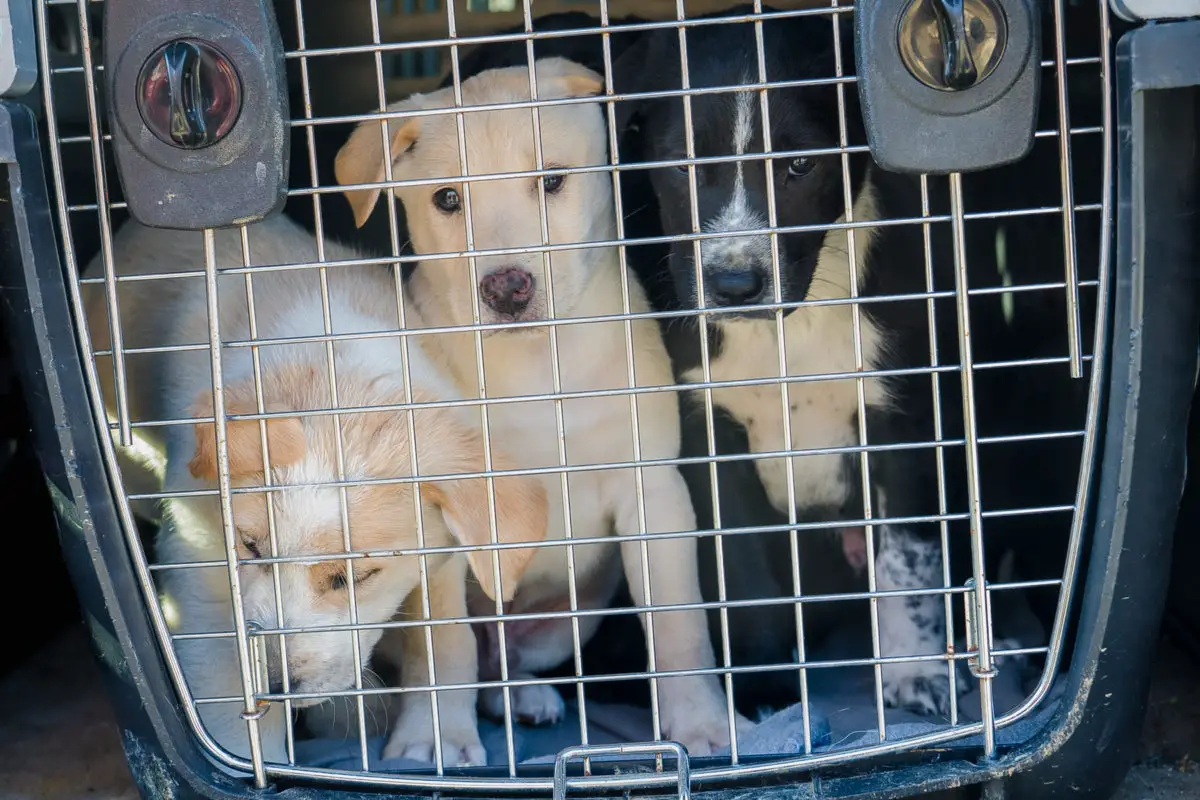
Catahoula Pups – Photo Nancy Slattery
The rest of the day wasn’t much different. We visited tiny pounds, which were basically sheds with kennels in them and met more friends of Amber—committed women (and a few men) who were desperately, on their own dime and the dimes they could raise, saving every animal they could. After leaving Amber, we stopped at a colorful, local restaurant in town for dinner. She later asked me how it was, and I told her the food (and the milkshakes) were amazing. I was surprised to hear she had never been there, but then I realized that her life is rescue. There is no time for dinner out and no money to pay for it. All of their time and money is spent on saving animals.
As we headed to Nashville the next day, I wondered, “Who was saving all these animals before Amber started?”
In Alabama, many counties simply don’t have a shelter. Alabama actually has a law, a decent law, that requires every county to provide a shelter or to pay their portion to support a shelter in a neighboring county. One local official told me that at least 60% of the counties are out of compliance with the law. Lacking a shelter, residents take it upon themselves to deal with unwanted dogs or leave it to the police. No one is recording those deaths either.
Safe Haven Animal Rescue Kennel (SHARK) – Alabama
We drove all the way to the bottom of Alabama to the ‘wiregrass corner’ to see the rescue, SHARK (Safe Haven Animal Rescue Kennel) that effectively operates as animal control and built their main shelter on county land (in the landfill). They receive $2000/year from Henry country and $2000/year from Abbeville city to handle the animal control calls for the area. Dave, a 76-year-old disabled veteran, is the current leader of SHARK. He is a trained animal control officer but is not paid for that position. He told me the county offered to pay him $10 per call, but he never remembers to bill them. Technically, the county and city are in compliance with the law, at least if you believe you can shelter and save over one thousand animals in a shed with no AC or heat on $4000 a year.
Dave and a battalion of volunteers (mostly retirees) do manage to shelter and save those animals, even raising the funds to spay/neuter and vaccinate, treat medical issues, and house them for an average of three months before Dave personally drives the dogs to meet rescues all over the country, even as far as Maine and Minnesota.
Dave calls the dogs, mostly Pit-Bull type mixes, his lambs (Lower Alabama Mixed Breeds). Following him up the aisle of the main kennel (there are four kennels scattered around the county to house the dogs – two in the landfill), it was clear how much the dogs adored Dave. In all my visits to shelters, never have I seen so many dogs silenced by the sight of one man. Every dog, sat (or jumped) at their gate, watching him, hoping he would stop and scratch them, offer a kind word, or let them out for a romp. I asked who had been there the longest. We always tried to showcase the long-time residents in our work in the hopes that it would help the dogs find a family. He pulled out Lola, a fireplug of a dog who took two joyful laps around the outside of the kennels, before Dave called her to us and she bombarded us with kisses and collapsed on the ground offering her belly for rubbing.
Bouncing up the long, deeply rutted drive on our way out, I thought, “And what happens if Dave has a health issue or his crew of retirees truly retires?”
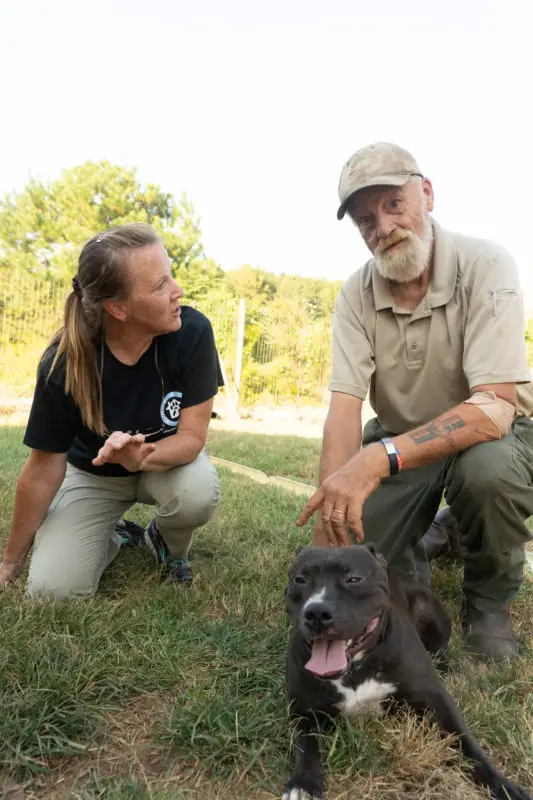
Dave and Lola at SHARK – Photo Nancy Slattery
South Carolina
In South Carolina, at a municipal shelter I walked past kennel after kennel filled with large, muscled, pit-type dogs. I stopped to share treats with several of them before slipping a lead on one large male named Kimbo. Kimbo waggled his butt the whole way out to the play yard. Once there, I scooped up a ball and tossed it for him. He pounced after it, but when he saw me sit on one of the benches, he dropped it and trotted over. He leaned his weight against me, his tail thumping the side of the bench hard enough to make me cringe. He set his front paws and head on my lap and I wrapped my arms around him. I think he would have stayed like that all afternoon. This dog was quite literally starved for human affection.
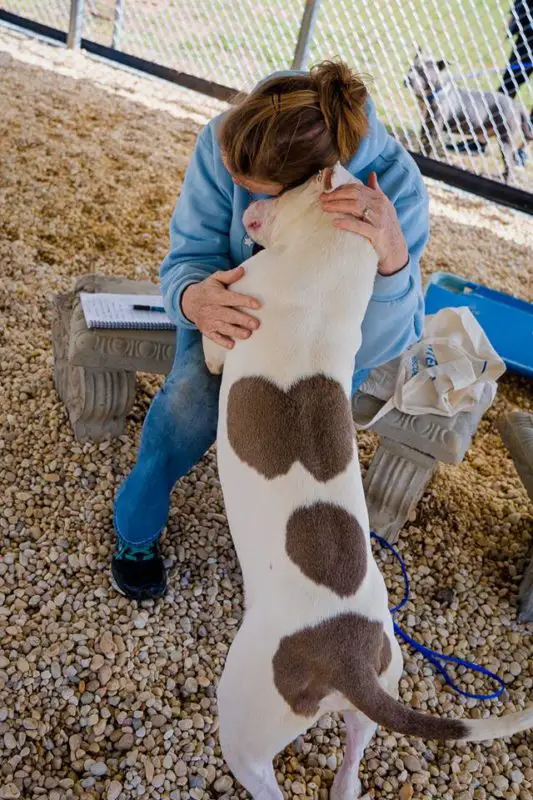
Cara with Kimbo at Newberry Shelter – Photo Nancy Slattery
Later when I spoke with the shelter director, she told me that the ‘Pitties’ linger at the shelter for months. I asked about the shelter’s ‘kill rate’ and she told me it was about 30%. Which dogs were most likely to be destroyed? Dogs that showed any type of aggression, were severely injured or chronically sick, and bully breeds.
“We hate to do it but living here permanently is no life either.”
The shelter has play yards and a decent volunteer program, but the shelter itself is a large metal building with no windows. The sound is deafening. The dogs lie on cement floors, their only view a metal wall, or if they are in a center aisle, another dog. She’s right. That is no life for a dog, especially a ‘pit bull’, dogs, who in my experience have high energy and intelligence, and love people beyond reason (and despite harsh treatment).
Like many of the shelters in the south, in South Carolina a dog’s best shot at life is with a rescue. Locals don’t need to come to a shelter for a dog—there are plenty available for cheap or free. Backyard breeders or people who ‘just want one litter’ or ‘wouldn’t do that to their dog’ (meaning spay/neuter) provide a steady supply of puppies. The ones that don’t find homes, end up as strays or surrendered to the shelters. This time of year is ‘puppy season,’ and rescues like the one I foster for are inundated with older puppies—no longer quite as cute but requiring training they’ve never gotten. Almost all are unvaccinated and at risk for parvo, heartworm, and any number of illnesses.
Missouri
In the boot heel of Missouri, we visited with Dave, a city employee in the tiny town of Hyati (pronounced Hay-tie). He is officially the street supervisor and unofficially the animal control officer; he has no training, he’s just the guy who likes dogs. The Hyati county pound is four kennels on the side of the Maintenance building. Dave, with the help of a rescue just over the state line in Tennessee, has procured heat lamps and dog houses for the kennels, and recently installed a small shed to store the dog food donated by a local merchant. Last year, Dave told me, the county took in 78 dogs and paid to euthanize all 78 after their legal stray hold (five days) was up. Dave is in charge of the dogs now and despite the directive from the town council to destroy them once their stray hold is up, he wants to save the dogs. He has partnered with a local rescue and is lobbying to get real animal control training. There is a serious stray dog problem in Hyati, we saw it firsthand when we helped Dave catch some stray puppies and were pursued by their parents, who live off hand outs from the local gas station mart. After we caught the two large, mostly feral puppies, Dave found a rescue to take them, saving their lives.
It’s admirable what Dave is doing and I’m hopeful for Hyati, but again, I thought, “What happens when he gets tired of the hours chasing down dogs, the resistance from his employer, and responding to all kinds of calls at every hour of the night, while also doing his street supervisor role and raising a family?”
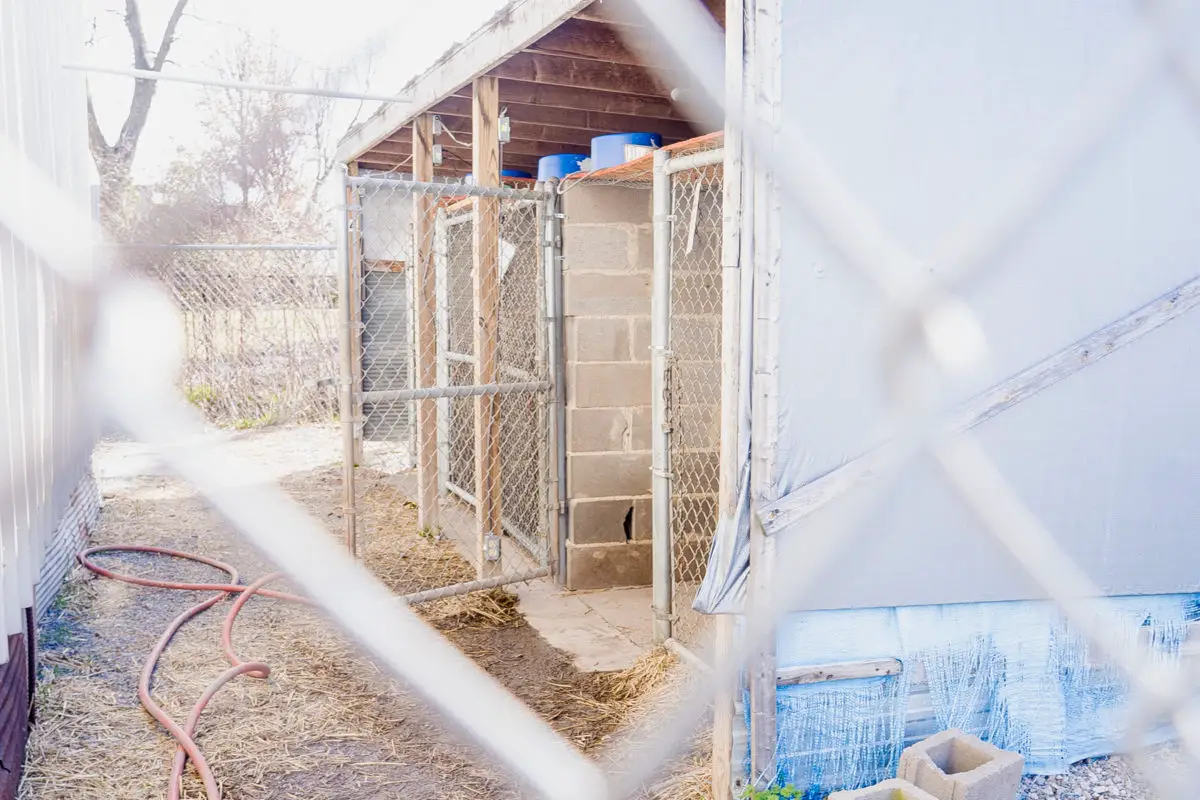
Dog Pound in Hyati – Photo Nancy Slattery
Virginia
In the southwestern edge of Virginia, along the Tennessee border, we stopped to visit a shelter in Scott County. The building is literally next to the county dump. They only house dogs, not cats, because the county has deemed cats, ‘free-roaming animals’ and thus has no responsibility to them. The shelter is another metal building with narrow cement runs that slope towards the center aisle so they can be sprayed out easily. The county pays an employee to care for the dogs five days a week, but if not for the volunteers of the Scott County Humane Society, they would go unfed and kennels uncleaned on the weekends. SCHS works hard to find rescues to take the dogs, knowing that if they don’t, the dogs won’t make it out of the shelter alive. When they are in a pinch, they have a few foster homes they can call on, or they pay to board a dog. Once again, I was amazed by the dedication of these dog-hearted people who give all their free time and all their extra income to help dogs that do not belong to them and to whom they bear no legal responsibility.
The idea that we could be a no-kill nation by 2025 is a beautiful one, but until we address the areas that are completely underserved in terms of animal sheltering and veterinary access, it will always remain a fantasy. Sure, in the places with shelters in place and communities that support them, progress is being made, animal populations are being secured.
Their reports are encouraging and exciting. But it’s the places where no one has time to keep records and counties shrug their responsibilities off on people whose hearts cannot turn away, it’s those places where the dogs and the people who rescue them are
suffering. No one is reporting those numbers to Best Friends or anyone else for that matter. The only people who keep count of the dogs that are dying are the people sacrificing everything to save them.
Cara Achterberg is the author of 100 Dogs & Counting: One Woman, Ten Thousand Miles, and a Journey Into the Heart of Shelters and Rescues (July 2020, Pegasus Books). She is also the co-founder of Who Will Let the Dogs Out (and initiative of Operation Paws for Homes), which seeks to raise awareness and resources for shelter and rescues in the southern US. For more information, visit CaraWrites.com.
Article written by Author: Cara Achterberg
